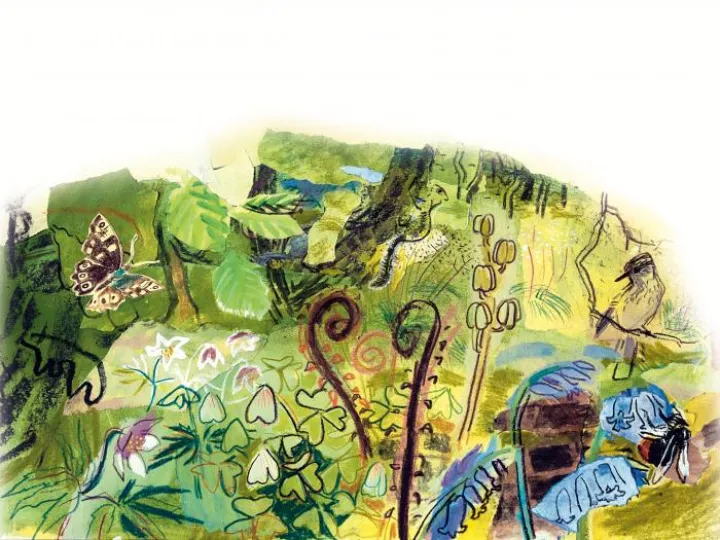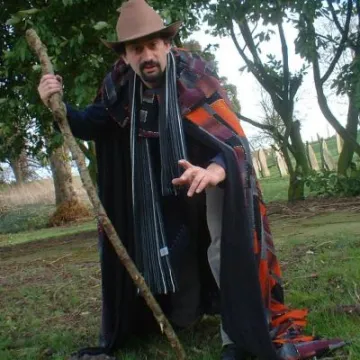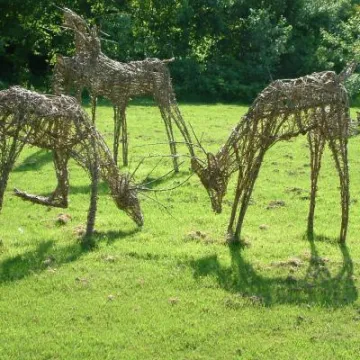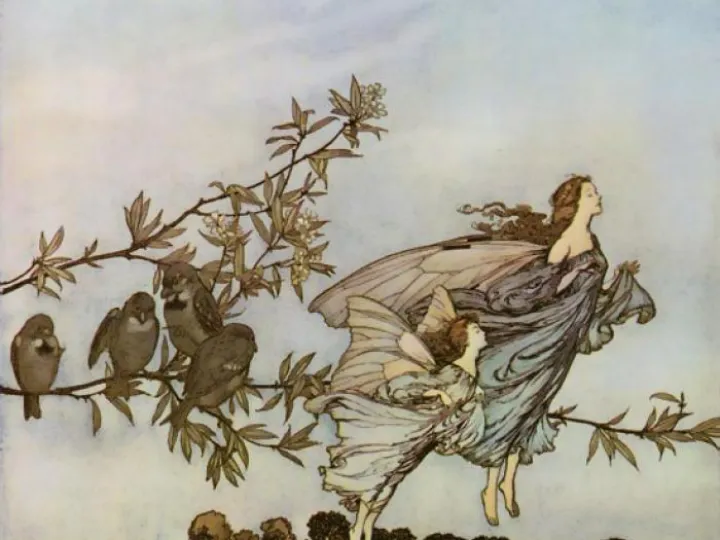Inspiration
The panoramic views from the Sandstone Ridge, abundant wildlife and rich heritage have captured people's imaginations for centuries, and continue to be a great source of inspiration for artists, photographers, poets and performers. The great English artist JMW Turner, for example, sketched and painted the dramatic ruins of Beeston Castle in the early 19th century. A century later, the Bickerton Hills were being visited by a young Wilfred Owen on family holidays and first inspired his love of poetry.
Today a number of high quality artists and craftspeople live and work along the Ridge, or exhibit at exhibitions in venues like Castle Park Art Centre in Frodsham.
The southern part of the Ridge played host to a brand new 'Sandstone Ridge Festival' in 2017. An exciting programme of concerts, exhibitions, talks and guided walks took place in Malpas, Tattenhall, Bunbury and Burwardsley.
The Heritage Lottery funded Habitat and Hillforts Project (2008-12) included a number of performing and public arts projects to support the interpretation of the Sandstone Ridge, including:
- Courses linking the arts and the environment, drawing on the expertise of local artists and run by the Harthill Creative Centre (read Fertile Ground for a beautiful record of their achievements)
- Story telling by the "Journey Man" – Johnny Gillett, who in July 2009 walked the length of the Sandstone Ridge over 4 days, stopping each evening at one of the hillforts to tell local stories he has unearthed linked to the Sandstone Ridge
- A local history project about the living history of the Sandstone Ridge, compiled by Barbara Foxwell and David Joyce, which captured local people's memories about this fascinating landscape, and published in "Captured Memories"
- A digital artist in residence (Patricia MacKinnon Day). The output from her residency was her exhibition; a set of six time lapse films of sites across the Ridge, through night and day and over the seasons.
- A production commissioned Jointly with the Arts Council 'Forgotten Fortress' by the Chester based "Theatre in the Quarter". The play was written (and new music composed) in the light of research amongst the Sandstone Ridge community, and performed 20 times in venues up and down the Ridge.
The wildlife artist Kim Atkinson painted a series of beautiful watercolours for a range of interpretative material which responded to and celebrated the sense of place of the Ridge and its many and varied special qualities.
The spirit of the Ridge was eloquently captured by the 2004 Cheshire Poet Laureate John Lindley in his poem "Stone by Stepping Stone".
An article which appeared in the British Newspaper Archive in 1879 and which is fully printed below also gives an insight into this unique landscape and its particular nuances ...
- The Sprite of Mickledale
- This story was told by James F Robinson in The Cheshire Observer 4th Jan 1879.
James Frodsham Robinson was a chemist, druggist and botanist whose shop was in Main St, Frodsham. Arthur R Smith describes his life in detail in his book "Brief Lives".
Mr Robinson begins by describing Mickledale, on Overton Hill, as consisting of two farmhouses and a few shepherds' cottages, although it was once known by the grander title of Mickledale Hall. One farmhouse, almost in ruins, once sheltered the non-conformist minister Matthew Henry, who preached there for several months. Nearby were traces of an ancient British fortification and remains of Druidical worship.
Nearby, across two meadows lay the secluded valley of Dunsdale, enclosed by high masses of red sandstone. It was also known locally as Dungeon-dale Glen or Dungedale. At the head of the Glen, near to Mickledale, was a small well beneath the "beetling" (overhanging) cliff, hidden from view by elder bushes. On the face of the rock above the well grew a very rare moss, Orthodontium gracile, only found in one other place in Britain. Lily of the Valley also grew wild in the valley.
Mr Robinson tells how Earl Rivers of Frodsham Castle had given the tenancy of Mickledale Hall to one of his Knights as a reward for his courage, loyalty and perhaps to keep him near in case of attack by the Welsh. The Knight also had charge of the beacon on Beacon Hill. The Knight, wandering through Dunsdale Glen one moonlit autumn evening, perhaps contemplating mans' immortality, heard the sound of feasting and merrymaking.
He could see no-one, but on going to the edge of the cliff he heard a shrill trumpet call and silence fell over the lonely Glen. The Knight recounted this story to the sentinel who occupied a hut next to the beacon, but he had no explanation for the events. The sentinel advised the Knight to tell no-one but to return to the same spot the following evening. Both attributed the sounds to local bandits hidden in a cave and by keeping silent they could capture them and rid the country of some robbers.
The following evening the Knight returned to Dunsdale. Although acting as eaves dropper went against the grain for this open and honest Knight, he hid in the furze and waited. Near midnight he heard the distant sound of a shrill clarinet, joined later by other instruments. He could not see anyone but thought that the music came from the vicinity of the well. Unfortunately the rocks beneath his position acted as a canopy over the well, so he decided to go to the head of the Glen to get a better look. As soon as he appeared in the open meadow the music ceased and an examination of the well and nearby rocks showed no signs of a cave where the musicians could have hidden.
The following day he made a hide from the heath and bushes, positioned it near to the well and hid there until evening. The wait paid off. On a small mound, favoured by local rabbits, he spied a party of little people preparing for a feast. He remained quiet, not wishing to disturb the fairies, but he was drawn to a small carved goblet on a cloth in the centre of the party. When a waiter took the elegant cup to the well to fill it with the clear sparkling water, the Knight gently took it from him. The waiter screamed, alerting the fairies, who fled. As he was leaving one of the bolder fairies uttered the following curse.
"If ever this cup shall break or fall
Bad luck shall come to Mickledale Hall"
The Knight ignored the threat and took the goblet home where it became a curiosity and was viewed by the wealthy and the nobility of the land. However he never let the goblet out of his hands and had an iron chest made to keep it safe.
Upon the death of the Knight, the goblet passed into the possession of Earl Rivers. One of the English Princesses visiting Rocksavage Castle heard about the goblet and visited Frodsham Castle to inspect it. Earl Rivers flattered by the visit, allowed the Princess to hold the goblet, which she carelessly dropped on to the stone floor of the reception hall and it broke in two. The Court Chronicles of the day reported that it was quite accidental and State Papers, now held at Windsor, reported that the fairies, in great glee, celebrated for three months, dancing round Mickledale , singing this refrain.
"Let us say, let us say
Farewell to luck
Come along bad luck,
Fairies dance till dawning of day
Good folks all, good folks all
Farewell good luck
Come along bad luck
Fairies joy at Mickledale Hall"
Mr Robinson concluded his story by saying that the ancient Mickledale Estate was still barren and desolate. The old Dunsdale Glen was very slightly altered, and that the good fairy folk had entirely deserted the whole region.
The original article, written by Mr Robinson in the poetic language of the time, can be seen in the British Newspaper Archive.
In my opinion it was on Earl Rivers and Frodsham Castle where the bad luck fell. John, Earl Rivers died on the 9th October 1654 and the following night the Castle was burnt down with his body inside. The Princess was probably one of the daughters of Charles I and he didn't have much luck either!
Sue Lorimer

Sandstone Ridge Trust
Registered Company No. 7673603
Registered Charity No. 1144470
info@sandstoneridge.org.uk






